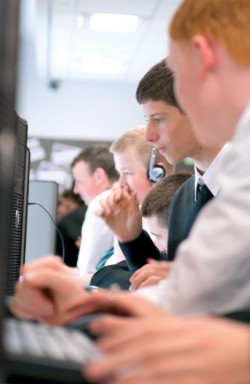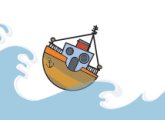
In recent years, the explosion in the use of internet-enabled technologies and social networking sites has dramatically transformed society. Many teachers around the country are increasingly using the internet and new technologies to lead fun and inspirational lessons, bringing the classroom into the digital age, but equally we know there are some for whom this can be a daunting challenge. Whatever your take on the digital revolution, however, there's definitely no avoiding it. Cyberspace provides enormous opportunities for young people, both for education and entertainment, and as educators, we have a responsibility to support young people to enjoy these opportunities safely and responsibly.
All together now
E-safety and digital citizenship (which includes issues like cyberbullying, the safe use of social networking sites, privacy, grooming, personal information and reputation management, copyright, sexting and plagiarism) should be understood as a whole school responsibility, and it is our experience that this is best achieved by highlighting e-safety issues across the curriculum, within a framework of effective policies and routes for reporting specific concerns. It is equally important that staff, pupils and parents are all aware of the school's policies, and are empowered with an understanding of the risks and precautions for staying safe online and what they can do if a problem arises.
Filtering solutions can certainly help schools minimise the risk of exposure to inappropriate material. However, it is important to be aware that they are never 100% effective, nor do they prepare young people for life outside of a filtered environment. It is crucial to educate and empower young people to know what to do if anything makes them feel uncomfortable online, and to raise awareness about the risks they may face, many of which concern their own behaviour and choices. When we go into schools we talk about risks of Contact, Content and Conduct – learning to manage these is a key part of the skills young people need to become responsible digital citizens.
Class action
Discussions about e-safety should be embedded throughout the curriculum. This doesn't have to be onerous! It could be in the form of a reminder of the school's Acceptable Use Policy before going online in a geography lesson to look at a live webcam of volcanic activity for example, or considering in an English lesson the need to critically evaluate materials found on the web as well as observing copyright restrictions. The cross curricular approach is very important – for young people the internet isn't just about going online via a fixed computer in an ICT lesson, it's an extension of their life. Bringing e-safety discussions into the wider curriculum recognises this and helps them see the relevance of these topics in their daily lives.
Addressing e-safety topics in Citizenship and PSHE gives young people the chance to explore how they interact with each other online, and what the potential risks are, and how to navigate these, look after themselves, their peers, and keep their moral values online as well as offline. There are many tie-ins with the Citizenship and PSHE schemes of work: you might be discussing rights and responsibilities in Citizenship – but what are a citizen's online rights and responsibilities? In a discussion around bullying, you could talk about cyberbullying too – how is it different? What role can everyone in the class play to prevent online bullying?
Topic focus: "Think before you post"
Being connected to friends, the internet and mobile technology 24/7, young people often don't have a chance to stop and think about what they are posting online or texting. How might their actions sometimes be hurtful to others? Is there anything they might regret posting online when they are older? Emphasise the point that once you have posted something online you have lost control of it.
Topic focus: Safe social networking
Social networking sites, like Facebook, are incredibly popular among young people. Show your pupils how to change their privacy settings to 'friends only' and help them consider who is on their friends list and who can see what they share. What would an employer think of their profiles? Our Know IT All Secondary Toolkit has a printable 'Friendbook' profile to help young people assess their social networking behaviour. Finally, prevention work can go a long way towards reducing risks faced by young people online, but sometimes things can still go wrong. As the UK Safer Internet Centre we operate the Professionals Online Safety Helpline, which provides tailored advice for teachers facing internet safety issues (both personal reputational issues as well as problems faced by their students, such as sexting and cyberbullying). If you need further support about any e-safety issues you can contact the helpline on 0844 381 4772 or helpline@saferinternet.org.uk.
Stay safe
Safer Internet Day provides a great opportunity to bring these issues into the spotlight and raise whole-school awareness. In 2013 it will be on Tuesday 5th February, so there is plenty of time to include this in your planning for the next academic year. To sign up for news and resources go to saferinternet.org.uk.
You too
It's not just young people that need esafety advice... as an educator, have you thought about your online behaviour?
• Review your own knowledge/behaviour/online content using this teacher's checklist, and read the helpful advice provided childnet.com/kia/traineeteac hers/technology.aspx
• What does your Facebook profile say about you? Google your name, review your content and friends, tighten your privacy settings and think before you post!
• Ask your school: What policies are in place and are these reviewed regularly? What filtering solutions does the school use? Have the school thought about running parents' sessions? Could your school do something for Safer Internet Day 2013?
• If you need further support about any e-safety issues you can contact the Professionals Online Safety Helpline on 0844 381 4772 or helpline@saferinternet.org.uk
Additional resources
• Know it all secondary toolkits addresses a range of esafety, with fully supportive lesson plans and accompanying resources childnet.com/kia/secondary/
• Digizen website watch an award winning film about cyberbullying, and play the digizen game to learn about how you can support people who face negative online experiences. digizen.org
• Jenny's story a dvd for secondary school pupils about the consequences of chatting online. order at childnet.com/order/
• Matrix of teaching resources find resources targeting different e-safety topics. childnet.com/kia/traineet eachers/matrix.aspx
• Childnet activity days childnet runs school activity days for secondary school pupils, and seminar presentations for parents and staff. email kidsmart@childnet.com to find out more.
About the author
Hannah Broadbent is a policy and research officer for childnet international, a non-profit organisation that was set up in 1995 to 'help make the internet a great and safe place for children.'










